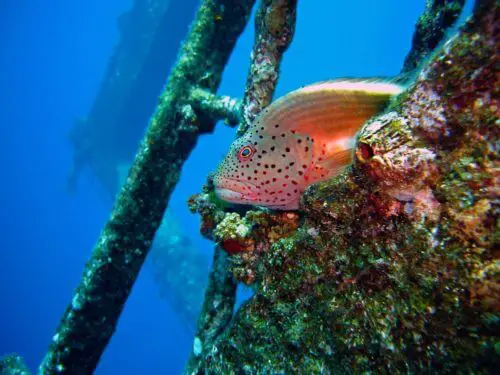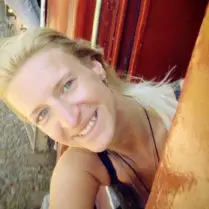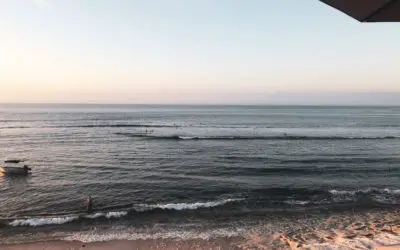When I think about diving in Bali I think about colorful corals, massive schools of fish, large pelagic species, shore diving, muck diving sites, wreck diving, cave diving, manta rays, and mola molas. Bali offers great diversity for divers of all levels. This little island draws tourists and divers from all over the world, and even if it is part of Indonesia, it kind of feels like a complete destination on its own. Combining the magnificent underwater world, its top dive sites, and outstanding marine life with all that Bali has to offer on land is makes this island a must-visit for divers. …or for anyone really. So dive into my guide on the top Bali dive sites as you prepare for a scuba diving vacation of a lifetime.
Bali is a year-round diving destination but you´ll find the best diving from May to November. The Mola Molas can be seen between August and October.
For diving outside of Bali please check out my guide on diving in Indonesia.
The 11 best spots for diving in Bali
Menjangan Island | Amed | Seraya secrets | Usat liberty wreck in Tulamben | Drop off in Tulamben & Tulamben wall | Manta point Nusa Penida | Crystal bay in Nusa Penida | Bat cave in Nusa Penida | Padang bai | Candidasa | Gili Biaha | Freediving | Good to know about Bali diving
1. Menjangan island
Most tourists head to the south tip of Bali, Kuta – Denpasar – Uluwatu, but for divers, the place to be is the protected island of Menjangan, at the very west end of the island, on the road to the ferry going to Java. The island remains almost untouched thanks to its remote location. Since the creation of the West Bali National Park in 1917, a lot of conservation efforts have been made in the area. Thanks to these efforts the coral and ecosystem around the island thrives. The colors are amazing even in shallow waters making it an excellent destination for those travelling with non-divers that can enjoy the underwater world while snorkeling instead. On top of that, Menjangan island is also famous for an absolutely stunning drop-off wall with dives ranging from 20 to 60 meters and with visibility sometimes reaching up to 50 m (164 feet).
Because of the wall and amazing deep diving, it is the spot in Bali with the most reported cases of decompression sickness, so here it is even more important than anywhere else around Bali to watch your depth and never dive without a dive computer.
Diving in Menjangan is perfect for beginners. The current is very light and you can dive easily on the reef flats around 10 meters deep. The walls and the very colorful and vibrant soft and hard coral offer underwater macro photographers special opportunities to capture some beautiful shots.
Menjangan island is really great for small and medium fish but you won’t see lots of big pelagic fish. However, you can spot blacktip and whitetip reef sharks and Manta rays at certain times of the year.
To get to Menjangan Island it is preferred to go via one of the local dive centres in the village of Pemuteran or Lovina.

2. Amed
On the black sandy northeast coast of Bali, you find the sleepy and quiet fishing village, Amed. It is the perfect destination for scuba divers looking for an authentic Balinese experience while enjoying a relaxing atmosphere along the sea. In Amed, you find both wall and muck diving, and to add to the experience you transfer from the beach to the dive sites with a traditional jungkung boat. A jungkung is a traditional fishermen’s boat of Balinese origin that is common in both Indonesia and the Philippines. Heading to the dive sites in a small wooden sailboat that looks like a canoe with two outriggers and a triangular sail surfing right at the surface of the water while embracing the traditions of the local fishermen is an unforgettable and unique experience. …however, most of them have scrapped the sail for a small outboard engine.
Amed is located in a bay, therefore, the water conditions are particularly calm and mild. The water temperature varies between 26 ° and 30 °, all year round. Diving in Amed, there is something for all levels and all tastes: first dives, beginner divers, divers in training (i.e. open water diver and advanced open water), experienced, professional divers, photographers, and macro enthusiasts.
The diversity of the dive sites in Amed are countless. Wrecks on the sandy bottom, magnificent drift dives filled with corals and marine life. Walls plunging into the depth, artificial pyramids in the sand, and drift and current dives. It doesn’t matter what toots your horn, there´s something for everyone in Amed.

3. Seraya secrets
For those who aren´t already into diving, muck diving can seem a bit repulsing. An experienced diver knows very well that behind the “muck”, generally a silty seabed of sand, you can find the most incredible tiny creatures. I didn´t really think it would be my thing, I wanted turtles, sharks, whale sharks, you know, all the big stuff. Until I tried muck diving and became hooked.
On the bottom of the sea, in the muck, you find the nursery for a lot of sea creatures, pipefish, nudibranchs, or seahorses just to mention a few. It´s a little bit like a treasure hunt and it takes both a well-trained eye and some patience so I suggest going with a Balinese Divemaster, that eagerly will show you everything.
The perfect place to discover muck diving is Seraya Secrets. While you´re already in Amed, Seraya Secrets is just around the corner and easily reachable through one of the local dive centers there. If you want to hit the jackpot, make sure to take night dive there and discover things you´ve never encountered before.

4. USAT liberty wreck in Tulamben
Just 30 minutes north of Amed you find one of the most famous wreck diving sites in the world, USAT Liberty Wreck. During WWII the American ship USAT Liberty was torpedoed down by a Japanese submarine. The ship was actually torpedoed between Bali and Lombok but was later towed to the beach of Tulamben and is now located just 25 meters off the beach, making it a shore dive. This means you can easily walk out to the dive site, making it a great dive for divers of all levels.
To make it even better, the volcano eruption of Mount Agung in 1963 pushed the wreck, that was being restored on the beach, back underwater and created one of the most dramatic coral reefs ever seen. To not miss the fantastic show of the different schools of fish swirling above the wreck you have to get there at sunrise. Your best option to do so is to spend the night in Tulamben. I highly recommend Tulamben Dive Resort. Great, modern, spacious, clean hotel rooms for a decent price (20 USD a night). The food in the restaurant is to die for and the pool area is nice and relaxing.
5. Drop off in Tulamben & Tulamben wall
The Tulamben Drop Off, also often referred to as the Tulamben Wall is one of the most popular dive sites in Bali. It has been created by the lava flow that pushed the Liberty wreck into the sea in 1963 after Mount Agung erupted. At the same time, it also created a breathtakingly deep wall descending to 70m deep. Starting at only 3m beneath the surface, with little to no currents and pleasant temperatures it can be visited by all levels of divers.
Because of the depth of this dive site, it is a highly appreciated dive site for the divers eager to learn technical skills such as trimix deep diving, to reach depths below 40m. You have a great chance of spotting white tip reef sharks and pigmy seahorses here.

6. Manta point Nusa Penida
I think it is every divers dream to dive with Manta Rays. Hey, I even would say it´s most people’s dream. Luckily some dreams do come true, especially at Manta Point Nusa Penida. I´ve been diving a lot and I have been lucky to see a fair amount of Manta Rays glide through the ocean. But nothing like at Manta Point Nusa Penida. As the dive boat pulls to a stop the divers and snorkelers on the boat are watching the surface crossing their fingers hoping to at least spot one ray. But it isn´t long until that hope changes into a pure eagerness to get inside the water. Because not only can you spot a few from the surface, once below and in the quite shallow blue, you spot what probably will be your largest amount of giant Manta Rays playing. They are so huge they can reach up to an average size of 3- 5 m. The Bali Manta Rays are the second-largest ray species after Oceanic Manta Rays and to have an encounter with these majestic creatures will definitely become the highlight of your vacation. And the encounter will be close, so close that I sometimes had to pinch me to make sure it wasn’t all a dream. And for those a bit hesitant, Manta Rays don’t have teeth and they also don´t have a poisonous tail, which makes this adventure perfectly safe.
However, even if this dive is quite shallow, with 10 to 12m deep on average, because of the currents in the area, it is recommended only for scuba divers with experience of diving in strong currents. Sometimes the boat captain calls the dive if he thinks the currents are too strong.
There is no specific manta season in Bali. The Mantas are present all year round thanks to the fact that the waters around Bali and the Nusa Islands enjoy the benefits of the Indonesian Throughflow – a massive stream that runs around the Indonesian archipelago from Timor to Bali. The flow transfers the water from the Pacific to the Indian Ocean. The Indonesian Throughflow is the largest movement of water on the planet meaning that the strait between Bali and Lombok always gets fresh nutrient-rich currents, which explains why the dive spots around Bali have such vibrant marine life. The fresh nutrient-rich water is also the reason why manta rays can be spotted all year round here.
There are plenty of Dive Centers both in Bali and Nusa Lembongan that bring you to Manta Point. For your best encounter with the rays, I would suggest making your dive from Nusa Lembongan. More specifically make your dive with Scuba Center Asia https://www.scubacenterasia.com/, this way you´re sure to be in the water before all other divers. Making this experience and even more majestic one. The price for half a day dive trip, including 2 dives, equipment, and a delicious, authentic Balinese lunch is 85 USD.
7. Crystal Bay in Nusa Penida
As if it wasn’t enough with the dance of the giant Manta Rays, Nusa Penida raises the stakes with another spectacular creature – the Mola Mola (Giant Sunfish). The Mola Mola can get larger than 3m and weigh more than 1000kg. They have an around and flat body with two long vertical caudal fins which doesn´t only make it very easy to recognize but also make them a sight rarely seen. In more than one way, because unfortunately, even during the high season between July and September, you will need to cross both your fingers and maybe even your toes to see it.
To increase your chances to hopefully encounter a Mola Mola go to the point of their cleaning station in Crystal Bay, located near Penida village, on the northeast coast of Nusa Penida, in the Ceningan Channel. Experienced divemasters know this and will take you straight there. Note that this is recommended for experienced deep divers as the observation spot is between 18m and 30m deep. Watch your depth, don’t do the dive without a dive computer. Be aware that as the Mola Mola loves cold water, the water at Crystal Bay I usually colder than other dive spots around. Wearing a 5mm full suit is therefore a wise choice.
I would recommend Scuba Center Asia for this, and for all dives around Nusa Penida and Lembongan actually. They are a really great dive center, with passionate, knowledgeable, and professional staff.
8. Bat cave in Nusa Penida
Nusa Penida is the gift that keeps on giving unusual and magnificent experiences. The Bat Cave dive site near Crystal Bay in Nusa Penida is something you will rarely get to experience. In this dive, you get an extraordinary combination of the thrill of underwater cave diving with the exploration of a cave that is only accessible from the sea. To find the entrance leading to the cave you need to dive to 30 m, meaning this dive is not for the inexperienced divers at all. To make the dive even more exciting, you´re likely to meet some white and blacktip sharks on the way before you enter the tunnel as well. The tunnel will get darker and darker until you finally see the light coming from the cave. Even under the surface, you will start hearing the high-pitched noise of the bats circling the cave. When surfacing inside the cave you´ll have hundreds and hundreds of bats flying above your head. It is nothing but a surreal experience, and if you have the skills and the guts, this is definitely one of the most thrilling dives I´ve done.

9. Padang bai
With everything from shark caves to muck diving, Padang Bai has several breathtaking sites to choose from. Located in East Bali, Padang Bai gives divers all the majesty that the Coral Triangle has to offer and Padang Bai is the perfect hub for day trips all around the island. At the shallow dive site, the Blue Lagoon, you find beautiful colorful reefs and you can expect to find lots of vibrant coral bommies, leaf scorpionfish, stargazers, octopus, eels, sharks, and if you’re lucky, seahorses. The Tanjung Jepun shipwreck is a small shipwreck that sits at around 17 meters (55 feet) deep. The abundance of macro critters here will not only satisfy muck divers but also make excellent subjects for underwater macrophotography. In Tanjung Jepun’s crystal clear waters you can also expect to find blue-spotted stingrays, turtles, triggerfish, reef sharks, and another schooling tropical fish.
Padang Bai is a spot ideal for all types of divers. The diversity of underwater options around Padang Bai makes it one of the best dive destinations in Bali.
10. Candidasa
Not far from Padang Bai is Candidasa. For some reason, the name makes me think about candy and even though the name has got nothing to do with candy, the dive sites look like they´re bedazzled with an array of candy in different colors and shapes.
Just 10 minutes from Candidasa, at Gili Mimpand and Tepekong unpredictable currents ensure that advanced divers will never get tired of diving these islands. You’ll find walls, slopes, healthy corals, white tip reef sharks, swim-throughs. The possibilities are endless. Gili Mimpang and Tepekong are famous for sightings, although rare, of the magnificent mola mola within season.

11. Gili Biaha
Gili Biaha is THE dive site for large pelagics. Located just a 15-minute boat ride from Candidasa, you can often spot patrolling reef sharks, gliding rays, tropical fish, and much more. This dive site is home to a shallow cavern sitting just 10 meters (32 feet) below the surface. It is a beautiful steep drop-off reef, nicely fissured and terraced in places. The drop-off rings most of the island, going into a slope on the north side. At the end of the rugged and terraced reef, the wall will lead into a blowhole. You can go into the cave but the only possible time to get into the blowhole is when a small surge laps the reef wall and water is pounded out from there. The strong current together with the low water temperature (20C) makes it a dive for experienced divers only. The visibility is incredible, up to 25 meters, the typography is completely different from elsewhere in Bali and the shark-filled cave together with the great chances of spotting Mola Mola’s males this a not to miss dive opportunity.
12. Freediving
Free Diving in Bali is huge. With the proper training, freediving doesn´t only open many more possibilities to enjoy the underwater environment but also teaches you how to truly relax and to be absolutely present in the moment. Learning how to free dive isn´t as hard or as time demanding as it may sound. You´ll actually learn and be able to benefit from your training within no time. Broadly defined, freediving is swimming underwater while holding your breath. But freediving is more than that. Freediving is a unique way to explore the ocean in the most comfortable way. Freedivers learn and practice breath-holding techniques that allow them to hold their breath for long periods of time and dive to depths beyond what is possible for recreational scuba divers. Freediving is an exploration of the body and the mind. It´s both calming and therapeutic. To be a successful freediver, one must train the mind to achieve a deep state of relaxation and calmness in order to use the least amount of oxygen possible and to overcome the urge to breathe.
I learned how to free-dive with Fusion Freedive in Ahmed and I can highly recommend the experience. If you´re in Nusa Penida and you can spare the money, a once-in-a-lifetime retreat is Fluid Focus Freediving & Yoga Retreat, by Blue Corner Dive. This retreat truly is something and you will learn the fundamentals of freediving as well as a wide array of topics that apply to everyday life. The retreats were created after the mantra that anyone can learn how to free dive. It´s a 7-day retreat in the most gorgeous and luxurious villa and includes three homecooked meals per day. Of course, the meals are prepared with the freshest locally produced ingredients. Freediving and breathing sessions are combined with daily workshops about island conservation, freediver physiology, pranayama yoga, manta biology, neuroscience, and everything around and between. You get daily yoga classes, freediving with Mantas, nightly cool-down meditations, guided visualizations, and other activities in order to promote better sleep. The retreat is all-inclusive, meaning that everything from transport to and from the retreat, to meals, gear, and scooter rental during the entire retreat is included. The cheapest option is 1300 USD so it doesn´t come cheap, but for me, it truly was a life-changing experience on so many levels.

Good to know about Bali diving
1. You will encounter a lot of sharks. While it might be either intimidating or exhilarating it is important to remember to move slowly and steadily and relax your breathing.
2. Never approach or chase the shark, be a respectful visitor instead and observe it with minimal disturbance.
3. Bali offers world-class diving but it comes at the price of strong currents that can come with little to no warning. Be prepared and stick to your buddy and diving group. …and don’t forget your reef hook. It could save your life.
4. There are a lot of tourists coming to Bali, meaning that there are fewer serious dive operators out there. Do your research before choosing one.
5. Even if you´re not into diving, a lot of the spots are perfect for snorkeling and most dive centers bring snorkelers on the boat. Perfect if your travel buddy isn´t into diving but you still want to share the experience.
6. Most dive centers only provide short wetsuits. If you get cold easily make sure to bring your own full suit or some protective gear. The waters can become surprisingly cold!
Where do you plan to go diving in Bali next? Let us know in the comments below
Like it? Pin it ?



Related Posts
Your Best Guide to Diving in Raja Ampat
The Raja Ampat archipelago is paradise on earth. For divers and non-divers alike. This remote group of islands is pictured over and over again in magazines, travel blogs, postcards, and more. Because let’s be honest here, the rocky islets surrounded by the clear blue...
The ultimate guide to diving in Indonesia
I don´t know where to start. When I think about diving in Indonesia I get the chills. In a good way. My eyes can even start to tear up a bit. That’s how absolutely wonderful it is. I have had some of the best dives of my life here. I have seen things I could only...
Canggu Villas Bali
The options of villas available in Canggu, Bali are endless. With it being the most popular spot in Bali now for tourists and ex-pats alike you’ll be spoilt for choice. Of course, you can stay in a hotel or guesthouse still but there are some incredible villas in...
Is it Safe to Travel to Bali at the Moment? By Someone in Bali
I originally wrote this post to answer the question of "Is it safe to travel to Bali at the moment?" because of the earthquakes and volcano eruptions that had been happening around Bali. UPDATE CORONAVIRUS SAFETY IN BALI: If you're looking at this post at the moment...
Bingin Beach Bali
Bingin beach, in the Pecatu area, is one of the cutest beaches in Bali by far. Unlike other nearby areas where most of the restaurants and bars are situated upon the cliff looking down in Bingin, they’ve built everything on the cliffside and it makes for a beautiful...
Green Bowl Beach Bali
Green Bowl Beach, in Bali, is a very quiet, small tucked away surf beach in the Ungasan region of Bali. It doesn’t get that many people to it at any one time most likely due to it being situated down one of the largest amounts of steps of any of the beaches in the...













0 Comments